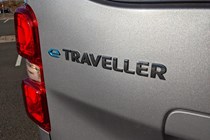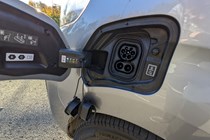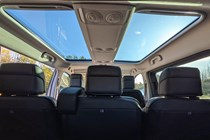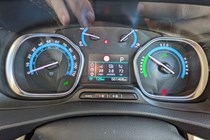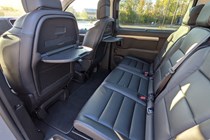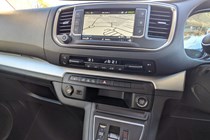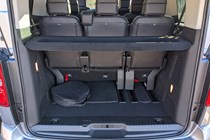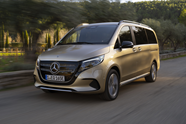
Peugeot e-Traveller MPV review
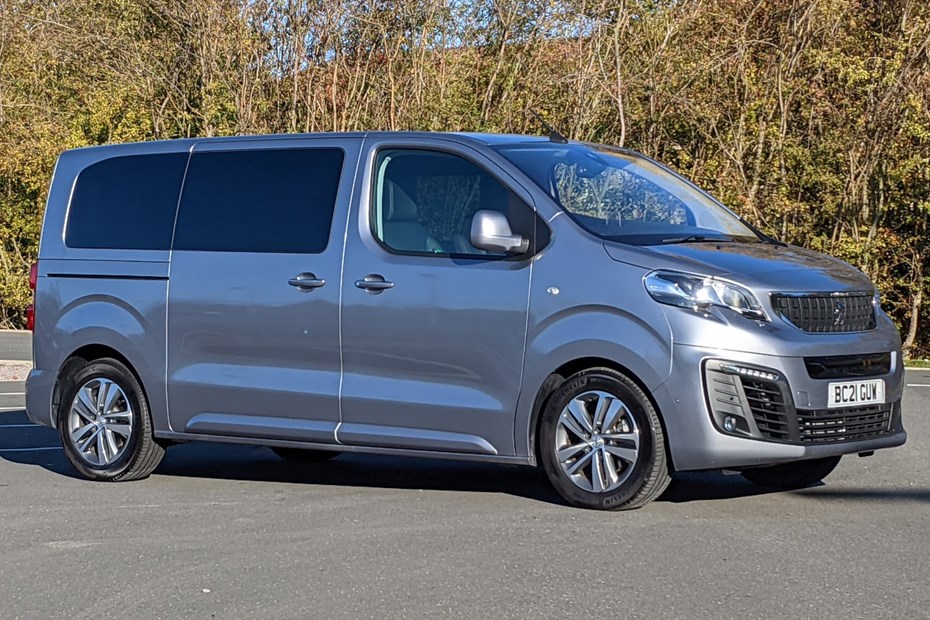
At a glance
| Price new | £48,925 - £56,640 |
|---|---|
| Used prices | £14,287 - £32,945 |
| Road tax cost | £620 |
| Insurance group | 34 - 39 |
Get an insurance quote with

|
|
| Fuel economy | 2.2 - 2.8 miles/kWh |
| Range | 122 - 230 miles |
| Miles per pound | 3.5 - 8.2 |
| Number of doors | 5 |
| View full specs for a specific version | |
Available fuel types
Fully electric
Pros & cons
- Smooth, silent acceleration
- Comfortable ride quality
- Lots of interior space
- Battery range is poor
- You can't get the van's larger battery pack
- Interior fittings lack quality
Peugeot e-Traveller MPV rivals
Overview
This is the Peugeot e-Traveller, and it is the latest addition to the growing ranks of electric van-based MPVs, also complementing its maker’s diesel-only Traveller range, which has been on sale since 2016. It’s a passenger version of the e-Expert van, although with many creature comforts available, you won’t be left feeling like a commercial vehicle driver.
If you’re a city dweller, who’s looking for a flexible and cheap-to-fuel people carrier, the e-Traveller could be right up your street. Although the appeal of van-based MPVs is limited because there aren’t that many people who need an eight-seater, it’s good to know that you can now go fully electric.
Rivals include the Citroen e-SpaceTourer and Vauxhall Vivaro e-Life, which, aside from a few cosmetic and pricing differences are essentially the same vehicle. If you have a larger budget, you could for for the Mercedes-Benz EQV – an electric version of the V-Class MPV.
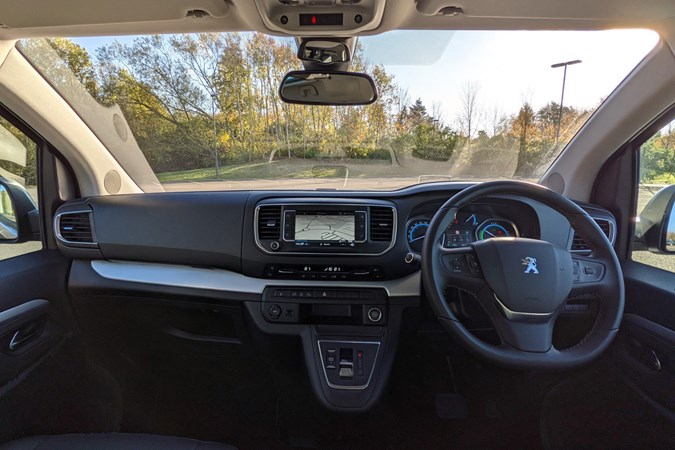
What’s it like inside?
The driving position is very upright as you’d expect with a van-based MPV, but it is a million miles away from commercial vehicles of old. Some members of the team have criticised it for having an uncomfortable pedal layout, although that’s not a view shared with everyone – so try carefully before buying.
The dash design echoes those of previous-generation Peugeot cars which lends it a rather dated air. The dashboard is easy to read, and the controls well laid out, once you’re used to doing it the Peugeot way of doing things – the column-mounted cruise control is a good example. However, the quality of the fixtures and fittings isn’t up there with, say, a Volkswagen Caravelle, and certainly lags behind the Mercedes-Benz EQV.
But accommodation for passengers and luggage are what the e-Traveller is all about, and it’s here that it does very well. Getting in and out of the rear is a cinch thanks to its sliding doors, and there’s lots of space and light thanks to the generous glass area and an optional glass roof. Legroom in the rear two rows is good enough to offer enough space for a six-foot adult to sit in – with the middle row being able to slide backwards and forwards to shuffle what room’s available.
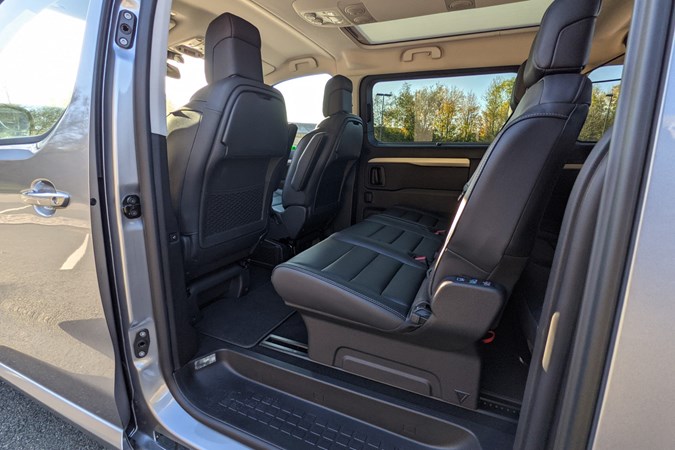
What’s it like to drive?
In short, it might look like a van, but it doesn’t drive like one. It is easy to steer, with excellent all-round visibility thanks to that high-set driving position, slim pillars and acres of glass. The steering is light, albeit low geared and lacking in feel, so you will have to twirl your arms a fair bit in tighter turns.
As you’d expect from an electric vehicle, the e-Traveller majors on smoothness and comfort, especially compared with more traditional diesel-powered rivals. First impressions are that it is smooth, responsive and nippy from the lights – a view that is reinforced the longer you drive it. The 0-62mph time is 13.1 seconds and maximum speed is 80mph.
With a useful 136hp and 260Nm of torque, there’s more than enough pulling power on hand. Despite not sounding particularly powerful on paper, the way an electric motor responds is totally different to a diesel, with all of its urge available all of the time. In a nutshell, this gives the e-Traveller with off-the-line performance to shame much more powerful rivals, even when loaded.
There are three driving modes to choose from. The least powerful is called Eco, which limits the top speed, cuts off the air-conditioning and throttles power back to 82hp in a bid to extract as much range as possible from the battery. Don’t use it if you’re in a hurry or loaded with passengers. Normal brings you 109hp and Power unleashes the full 136hp. Use it and expect to see the battery range tumble.
The ride comfort and handling are very good, and it really isn’t van-like to drive at all. This really is what you’d expect considering it’s so closely related to a selection of Peugeot cars under the skin, which will be a pleasant surprise if you’re a van-based MPV newbie.
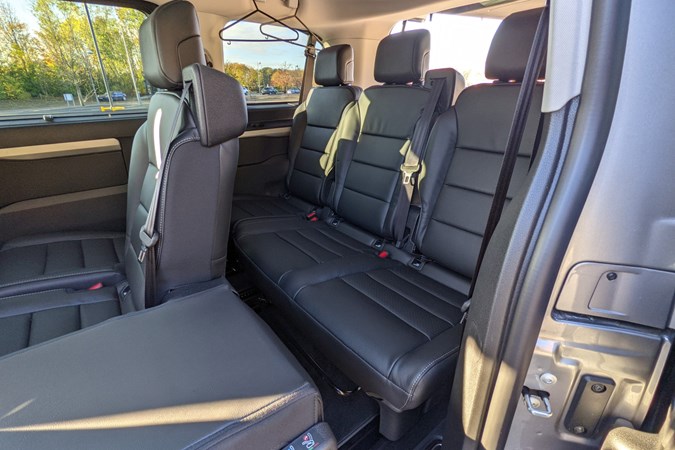
Peugeot e-Traveller range and charging
You won’t buy the e-Traveller for regular long journeys. The battery pack has a capacity of 50kWh, which restricts the distance it can travel between recharges. Officially the range is 143 miles, but that can easily drop to 100 in the real world when temperatures are low or it’s fully loaded. However, for short-hops, it’s fine.
Recharge times depend on your connection, with a flat-to-full replenishment using a dedicated domestic wallbox taking 7.5 hours. On test, we found a ‘very low’ to full charge-up using a 50kW public charger could be done in around an hour.
What models and trims are available?
The e-Traveller is available in long- and short-wheelbase forms: a 4.95m Standard model and a 5.3m Long version. It has a capacity of up to eight passengers, with as much as 4,900 litres of boot space when the rearmost two rows of seats are removed.
It’s available in Active and Allure trim levels, with both looking smart and well-equipped for the money – especially when compared with the Mercedes-Benz EQV. All versions offer a highly-flexible interior, with the second and third row seats that are fully adjustable and removable.
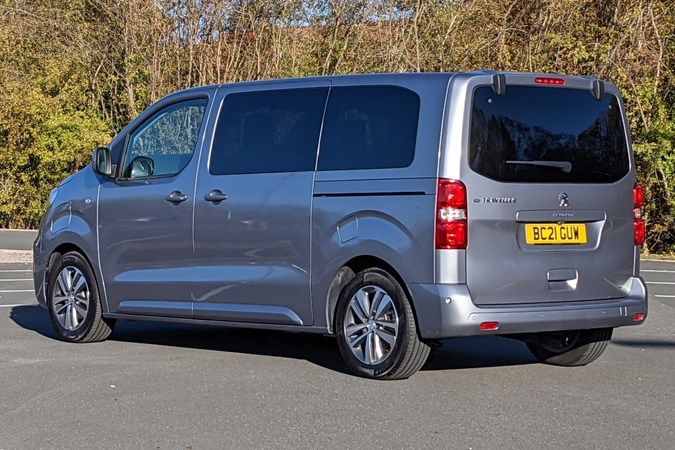
Active models get rear parking sensors, cruise control and highly-usedul twin sliding rear doors as standard. On the infotainment side, there’s a 7.0-inch touchscreen, which works with Apple CarPlay and Android Auto and also features a DAB radio with Bluetooth.
The higher-spec Allure adds a rear-view camera, keyless entry and start and electric sliding doors. The infotainment set-up is suitably upgraded with Connected 3D Navigation and a Head Up Display. Traffic sign recognition is also included, although blindspot monitoring and a 360-degree camera system – both useful on a vehicle of this size – are optional.
Continue reading to find out what we think of the Peugeot e-Traveller in the Parkers verdict.




